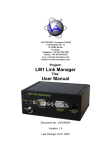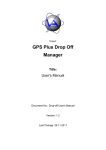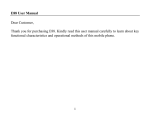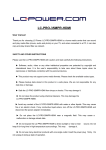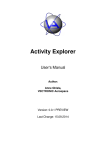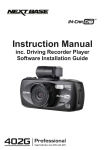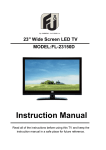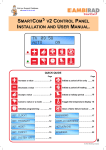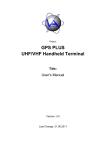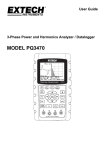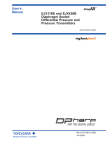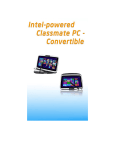Download Drop-Off Release Transmitter
Transcript
Project: Drop-Off Release Transmitter Title: User's Manual Document No.: Drop-off User’s Manual Version: 1.3 Last Change: 31.03.2011 Doc. No.: Date: Release Transmitter User Manual 31.03.2011 VECTRONIC Aerospace Name Date Signature Prepared by Annette KropBenesch 23.12.2010 Edited by Annette KropBenesch 31.03.2011 Checked by Approved by Authorised by This design is the property of VECTRONIC Aerospace GmbH. Unauthorized duplication or distribution to a third party is prohibited. VECTRONIC Aerospace 2 /20 Manual_DropOff-Transmitter.docx.doc Doc. No.: Date: Release Transmitter User Manual 31.03.2011 VECTRONIC Aerospace DOCUMENT CHANGE RECORD Issue Date Item(s) Affected Description 1 23.12.2010 - Initial Issue 2 01.02.2011 Installation Automatic installation of program and driver 3 31.03.2011 Battery Charger Addition LCD Battery Charger This design is the property of VECTRONIC Aerospace GmbH. Unauthorized duplication or distribution to a third party is prohibited. VECTRONIC Aerospace 3 /20 Manual_DropOff-Transmitter.docx.doc Doc. No.: Date: Release Transmitter User Manual 31.03.2011 VECTRONIC Aerospace Table of Contents 1 Product Overview ............................................................................................................... 5 2 The Release Transmitter ..................................................................................................... 6 3 Quick guide to the keyboard ............................................................................................... 7 4 Quick guide to the Release Transmitter .............................................................................. 8 5 Charging batteries and inserting them into the transmitter ................................................. 8 6 Connecting the Transmitter to the PC ............................................................................... 10 7 Drop-off list ...................................................................................................................... 11 8 Configuring drop-offs or upload new firmware ................................................................ 11 9 Releasing a radio drop-off................................................................................................. 11 10 The information menu ................................................................................................... 12 11 The UHF ID-tag receiver .............................................................................................. 12 12 Operating instructions for Sanyo AA/AAA USB Charger ........................................... 13 13 Operating instructions for VARTA LCD Charger 57070 ............................................. 14 14 Manual installation of the Release Transmitter driver .................................................. 16 This design is the property of VECTRONIC Aerospace GmbH. Unauthorized duplication or distribution to a third party is prohibited. VECTRONIC Aerospace 4 /20 Manual_DropOff-Transmitter.docx.doc Doc. No.: Date: Release Transmitter User Manual 31.03.2011 VECTRONIC Aerospace 1 Product Overview The Drop-off Release Transmitter enables you to communicate with VECTRONIC drop-offs and receive UHF ID-tag numbers. Its functions are: while the release transmitter is connected to the PC via USB cable, it transfers drop-off telemetry data to the computer and sends release times and firmware to the drop-off. Communication is managed with the GPS PLUS Drop-Off Manager software radio-and-timer-controlled drop-off can be released on demand within a range of 500 m by sending the release command from the transmitter the release transmitter is able to receive the IDs of VECTRONIC UHF-tags used for the proximity sensor. This design is the property of VECTRONIC Aerospace GmbH. Unauthorized duplication or distribution to a third party is prohibited. VECTRONIC Aerospace 5 /20 Manual_DropOff-Transmitter.docx.doc Doc. No.: Date: Release Transmitter User Manual 31.03.2011 VECTRONIC Aerospace 2 The Release Transmitter The release transmitter is switched on with the button. It will switch off automatically 30 seconds after the last button has been pressed. The release transmitter can be connected to a PC for configuration with an USB cable. The display will then show USB PC . The keys will not respond while the transmitter is attached to a PC via USB. After 30 seconds, the backlight of the display will be switched off; after 5 minutes, the transmitter will be switched off. It can be switched on again by pressing the button. Figure 1: Left: Release Transmitter, right: waterproof USB-connector with rubber cover as protection against dirt. Note: Never use the transmitter without an attached antenna! Otherwise you may severely damage the transmitter. Note: In the field, make sure the USB port is always protected by the rubber cover to avoid dirt entering the port. This design is the property of VECTRONIC Aerospace GmbH. Unauthorized duplication or distribution to a third party is prohibited. VECTRONIC Aerospace 6 /20 Manual_DropOff-Transmitter.docx.doc Doc. No.: Date: Release Transmitter User Manual 31.03.2011 VECTRONIC Aerospace 3 Quick guide to the keyboard The keyboard is designed to give you easy access to the features of the transmitter. The keys will not respond if the transmitter is attached to a PC via USB. Press briefly to switch on the transmitter. The transmitter will automatically give a list of all registered drop-offs. Press this button at any point in the menus to reset the transmitter and return to the drop-off list. Allows you to move up in the drop-off list or the menus Allows you to move down in the drop-off list or the menus Triggers the release of a radio drop-off Opens the transmitter information menu showing battery voltage, hardware version, software version, and serial number of handheld Activates the UHF ID-tag receiver Exits the menu or ID receiver and cancels the fire command Confirms the fire command This design is the property of VECTRONIC Aerospace GmbH. Unauthorized duplication or distribution to a third party is prohibited. VECTRONIC Aerospace 7 /20 Manual_DropOff-Transmitter.docx.doc Doc. No.: Date: Release Transmitter User Manual 31.03.2011 VECTRONIC Aerospace 4 Quick guide to the Release Transmitter 1. Charge the Eneloop™ batteries with the Sanyo USB battery charger and insert them into the transmitter (s. section 5) 2. Connect the Release Transmitter to the PC via USB cable (s. section 0) 3. Start the GPS PLUS Drop-Off Manager; it will automatically recognise the Release Transmitter. 4. Register the drop-offs on the transmitter. To do this, the drop-off first must be registered in the GPS PLUS Drop-Off Manager version you are using (refer to GPS PLUS Drop-Off Manager manual). Then you can register the drop-off on the transmitter. 5. You are now able to communicate with the drop-off and release it on demand if it is a radio drop-off. 6. To release a radio-drop off, refer to section 9. 5 Charging batteries and inserting them into the transmitter Before you are able to use the Release Transmitter, the included Eneloop™ batteries need to be charged. For this, use the included Sanyo USB battery charger only (for further details see Sanyo manual page 18). You can charge two batteries at the same time. Recharging time is approximately 5 hours. Raise the adjuster and insert the batteries into the charger. Then connect the charger’s USB plug to a USB port at your PC. Note: Make sure that no other equipment is connected to any other USB port or the required power might be exceeded. Charging might be stopped, the computer might be damaged, or data might be lost. While recharging, the LED charge indicator is flashing. When charging has been completed, the LED remains lit. Remove the USB connector from the USB port, then remove the batteries from the charger. They will be hot immediately after recharging. Repeat the process with the second pair of batteries. For storage, lower the adjuster. Note: Do not use the charger for any other batteries than Eneloop™. Open the transmitter by unscrewing the two screws on the back (see Figure 2, red arrows). Be careful not to damage the waterproof seal (see Figure 2, grey arrows). Carefully insert the batteries with the correct polarity (for details refer to picture in battery compartment and Figure 2). This design is the property of VECTRONIC Aerospace GmbH. Unauthorized duplication or distribution to a third party is prohibited. VECTRONIC Aerospace 8 /20 Manual_DropOff-Transmitter.docx.doc Doc. No.: Date: Release Transmitter User Manual 31.03.2011 VECTRONIC Aerospace To remove batteries from the compartment, knock the transmitter against your hand and thus loosen the batteries. Do not insert objects (e.g. screw drivers) into the compartment to force the batteries out. Figure 2: Back of Release Transmitter; red arrows indicate the screws for opening the battery hatch, grey arrow indicates the waterproof seal. Make sure the batteries are inserted with the correct polarity. Battery voltage of the release transmitter must not fall under 4.0 Volt. At 4.05 Volt, the display will warn LowBat. for a few seconds and switch off the backlight. At a lower voltage, the transmitter cannot be switched on anymore. Please recharge batteries with the associated Sanyo battery charger only. The rechargeable Eneloop™ batteries delivered with the transmitter do discharge very slowly. We advise not to exchange them for other batteries, since these might lose voltage during storage and might not be able to provide enough power to release the collar on demand. However, if in urgent cases you need to exchange the batteries, and you do not have an additional set of Eneloop™ batteries, you can use High Power Alkaline batteries (Do not recharge these! Danger of explosion!), NiCd rechargeable batteries, or NiMH rechargeable batteries with current rating > 1A. This design is the property of VECTRONIC Aerospace GmbH. Unauthorized duplication or distribution to a third party is prohibited. VECTRONIC Aerospace 9 /20 Manual_DropOff-Transmitter.docx.doc Doc. No.: Date: Release Transmitter User Manual 31.03.2011 VECTRONIC Aerospace 6 Connecting the Transmitter to the PC Easily connect the transmitter to a PC via USB cable. The transmitter is switched on automatically and the display will show USB PC . Thirty seconds after the last communication between PC and transmitter took place, the display backlight will be switched off. After 5 minutes, the transmitter is switched off. It can be switched on again by pressing the button. If the transmitter is connected via USB, it is supplied exclusively by the USB port; the output power is limited to 2 mW. The Release Transmitter is operated with the GPS PLUS Drop-Off Manager. If a transmitter is connected to the PC, it will be displayed in the upper left section of the program (“Devices”). Figure 3: Opening window of the GPS Plus Drop Off Manager with release transmitter connected to PC For using the software, please refer to the GPS PLUS Drop-Off Manager manual. You need to connect the transmitter to a PC for the following tasks: to register a drop-off on the transmitter; this is necessary to enable communication with this drop-off to change configuration of a drop-off This design is the property of VECTRONIC Aerospace GmbH. Unauthorized duplication or distribution to a third party is prohibited. VECTRONIC Aerospace 10 /20 Manual_DropOff-Transmitter.docx.doc Doc. No.: Date: Release Transmitter User Manual 31.03.2011 VECTRONIC Aerospace to upload new firmware to the drop-off If you use the transmitter as interface between PC and drop-off, the drop-off needs to be within a few meters of the transmitter and you must be able to detach and attach the magnet to the drop-off. 7 Drop-off list If you switch on the transmitter, it will automatically give a list of all drop-offs registered on the transmitter. The drop-off with the lowest number will be displayed first. Move upwards and downwards this list with the Up and Down buttons. 8 Configuring drop-offs or upload new firmware To configure a drop off, this is to change the release settings or to upload new firmware, you need to connected the transmitter to the PC and start the GPS PLUS Drop-Off Manager. For details please refer to the GPS PLUS Drop-Off Manager manual. 9 Releasing a radio drop-off The main feature of the release transmitter is to release a radio-and-timer-controlled drop-off on demand. The maximum range for this is 500 m. If possible, release the drop-off while you can see the animal. Note: Prior to preparing the drop-off release make sure the transmitter battery’s voltage is higher than 4.05 Volt. Otherwise there might not be enough power to reach the drop-off. Ideally, the battery voltage would be close to 5.0 Volt. Note: It is possible that the animal is startled when the collar is released and drops down. Avoid triggering the drop-off if the animal is in a situation where it could get hurt by erratic movements (e.g. on a cliff edge). To release a drop-off, switch on the transmitter. Scroll the drop-off list until you have found the ID of the drop-off you want to release. Press the button 5 seconds until Fire? is shown in the display. This is the last opportunity to abort the release. Press Exit/Cancel to abort. Press Enter/OK within 5 seconds to transmit the release command to the drop-off, otherwise the display will return to the ID list. If you press Enter/OK , the display will switch to Transm. … . The transmitter now sends the signal to the drop-off for 33 seconds. The only chance to abort the command in this stage is to press the button, but it is possible that the This design is the property of VECTRONIC Aerospace GmbH. Unauthorized duplication or distribution to a third party is prohibited. VECTRONIC Aerospace 11 /20 Manual_DropOff-Transmitter.docx.doc Doc. No.: Date: Release Transmitter User Manual 31.03.2011 VECTRONIC Aerospace drop-off has already received the command and releases anyway. After the command has reached the drop-off, it takes about 25 seconds to completely release the collar. Note: There will be no confirmation from the drop-off if the signal was received and the dropoff triggered. If you are not sure whether the collar has been released, you can resend the release command. 10 The information menu With F1 , you can enter the information menu of the transmitter. If you press F1 , the display will show Battery . Press Enter/OK to view the current battery voltage. Press Exit/Cancel to return to the menu. With the Up and Down buttons, you can scroll between the topics: Battery Voltage of the transmitter battery Hardware Version of the transmitter hardware Software Version of the transmitter’s software SerialNo Serial Number of the transmitter While the battery voltage is necessary for you to know to ensure enough power for the dropoff release, the other three topics are only of interest for diagnostics if there are problems with the transmitter. 11 The UHF ID-tag receiver The Release Transmitter can be used to check if VECTRONIC UHF ID-tags are in range. To do this, press F2 . The display will switch to ID-Rec. . Press Enter/OK to start searching for UHF-tags. The display will switch to ID. . While the transmitter is listening for UHF- tags, the dot will blink, even if no UHF-tag has been detected yet. The ID numbers of the received tags will be shown in the display, e.g. ID.65534 . If more than one UHF-tag is in range, the ID numbers will be shown alternately. Press Exit/Cancel to leave the ID- reception. This design is the property of VECTRONIC Aerospace GmbH. Unauthorized duplication or distribution to a third party is prohibited. VECTRONIC Aerospace 12 /20 Manual_DropOff-Transmitter.docx.doc Doc. No.: Date: Release Transmitter User Manual 31.03.2011 VECTRONIC Aerospace 12 Operating instructions for Sanyo AA/AAA USB Charger This design is the property of VECTRONIC Aerospace GmbH. Unauthorized duplication or distribution to a third party is prohibited. VECTRONIC Aerospace 13 /20 Manual_DropOff-Transmitter.docx.doc Doc. No.: Date: Release Transmitter User Manual 31.03.2011 VECTRONIC Aerospace 13 Operating instructions for VARTA LCD Charger 57070 ➊ Connect the charger with one of the three possible power sources: a) AC 100-240V by power adaptor b) DC 12V by car cord c) DC 5V (500mA) by USB cord ➋ Power on but no batteries in the charger: VARTA logo as power indicator. ➌ Insert either 2 or 4 AA or AAA rechargeable batteries into the battery compartment. The batteries must be loaded in pairs and should therefore have similar charge status. A mix of AA and AAA batteries is possible. Make sure that the batteries are inserted according to the correct polarity and that each battery is touching both contacts. ➍ The actual charging level is indicated by up to three bars per battery symbol. It will only take 10 seconds to do this power check. The result will be displayed on the blue LCD. ➎ After starting the charging, a new bar fixes its position at the filling of a further 1/3 capacity. Indication works as follows a) rolling bar(s) = charging b) all three bars fixed = charging finished c) empty battery symbol = no charge (error) ➏ The charging time is about 120mins (2 AA cells), 240mins (4 AA cells) and 150mins (2 or 4 AAA cells) and depends on the initial capacity and charging conditions. ➐ Charging time with USB-In function is around 5 hours for 2 and around 10 hours for 4 batteries. ➑ The automatic charging control function prevents the batteries from being overcharged. The battery performance is maintained by trickle charge. This battery charger is designed for use anywhere in the world (100-240V, 50-60Hz). If necessary, you may however need an adapter for the respective country. This design is the property of VECTRONIC Aerospace GmbH. Unauthorized duplication or distribution to a third party is prohibited. VECTRONIC Aerospace 14 /20 Manual_DropOff-Transmitter.docx.doc Doc. No.: Date: Release Transmitter User Manual 31.03.2011 VECTRONIC Aerospace Safety This battery charger is intended for use only with rechargeable batteries. Charging other types of batteries (alkaline, RAM, zinc-carbon) may cause the cells to burst and in the worst case result in injuries. The charger is equipped with a safety timer control, a delta V cut-off function and a temperature control function. Do not attempt to recharge any corroded, damaged or leaking batteries. Protect our environment Further information on battery disposal is available at www.varta-consumer.com. This design is the property of VECTRONIC Aerospace GmbH. Unauthorized duplication or distribution to a third party is prohibited. VECTRONIC Aerospace 15 /20 Manual_DropOff-Transmitter.docx.doc Doc. No.: Date: Release Transmitter User Manual 31.03.2011 VECTRONIC Aerospace 14 Manual installation of the Release Transmitter driver In some cases, the driver for the release transmitter will not be installed automatically. If this is the case, follow these steps for Windows XP: 1. Insert the VECTRONIC CD into your PC. 2. Connect the Release transmitter to your PC via an USB cable. Your PC will automatically try to install the device and the Found New Hardware Wizard will open: 3. Select “No, not this time” and click on “Next”. This design is the property of VECTRONIC Aerospace GmbH. Unauthorized duplication or distribution to a third party is prohibited. VECTRONIC Aerospace 16 /20 Manual_DropOff-Transmitter.docx.doc Doc. No.: Date: Release Transmitter User Manual 31.03.2011 VECTRONIC Aerospace 4. Select “Install from a list or specific location” This design is the property of VECTRONIC Aerospace GmbH. Unauthorized duplication or distribution to a third party is prohibited. VECTRONIC Aerospace 17 /20 Manual_DropOff-Transmitter.docx.doc Doc. No.: Date: Release Transmitter User Manual 31.03.2011 VECTRONIC Aerospace 5. Select “Search removeable media”. Go to the VECTRONIC CD and select the folder “Drop Off Manager \ USB Driver for Release Transmitter”. 6. Select continue anyway. The driver will now be installed. After the driver has been installed successfully, switch on the release transmitter by pressing the can now use the release transmitter. button. You Follow these steps for Windows Vista / 7: 1. Insert the VECTRONIC CD into your PC. 2. Connect the Release transmitter to your PC via an USB cable. Your PC will automatically try to install the device. 3. A warning will appear reporting that the device was not installed correctly. Open the Device Manager: Go to “Start” “Control Panel” “Hardware and Sound” “Devices and Printers: Device Manager”. This design is the property of VECTRONIC Aerospace GmbH. Unauthorized duplication or distribution to a third party is prohibited. VECTRONIC Aerospace 18 /20 Manual_DropOff-Transmitter.docx.doc Doc. No.: Date: Release Transmitter User Manual 31.03.2011 VECTRONIC Aerospace 4. Open the node “Other Devices” and double-click on GPS Plus Release Transmitter. 5. Click on “Update Driver”. 6. Select “Browse my computer for driver software”. This design is the property of VECTRONIC Aerospace GmbH. Unauthorized duplication or distribution to a third party is prohibited. VECTRONIC Aerospace 19 /20 Manual_DropOff-Transmitter.docx.doc Doc. No.: Date: Release Transmitter User Manual 31.03.2011 VECTRONIC Aerospace 7. Browse on the VECTRONIC CD for the folder “Drop Off Manager \ USB Driver for Release Transmitter” and click “Next”. 8. Windows will warn you that it cannot verify the publisher of this driver software. Click on “Install this driver software anyway”. Windows will now install the driver software. 9. After the driver has been installed successfully, switch on the release transmitter by pressing the button. You can now use the release transmitter. This design is the property of VECTRONIC Aerospace GmbH. Unauthorized duplication or distribution to a third party is prohibited. VECTRONIC Aerospace 20 /20 Manual_DropOff-Transmitter.docx.doc




















